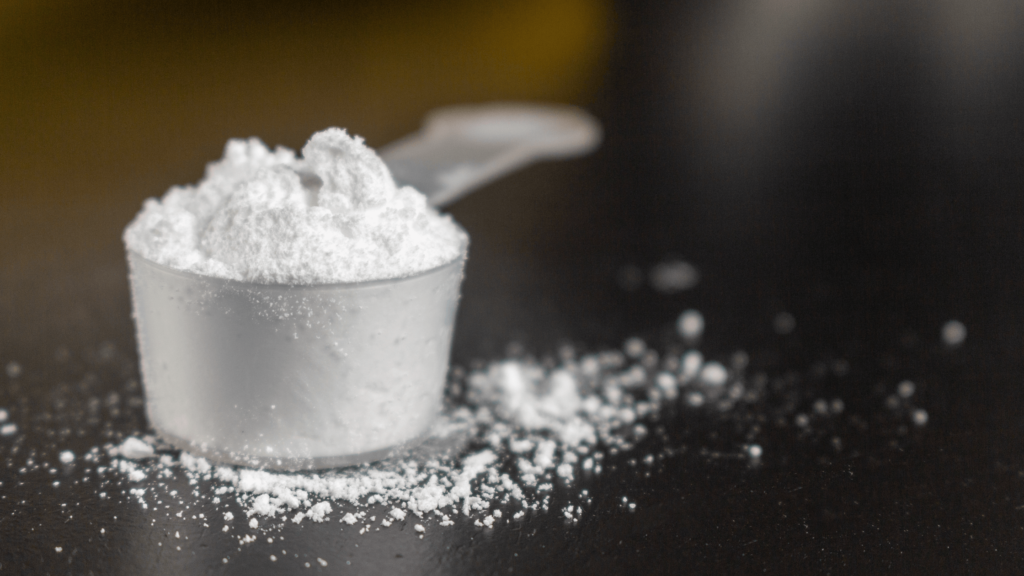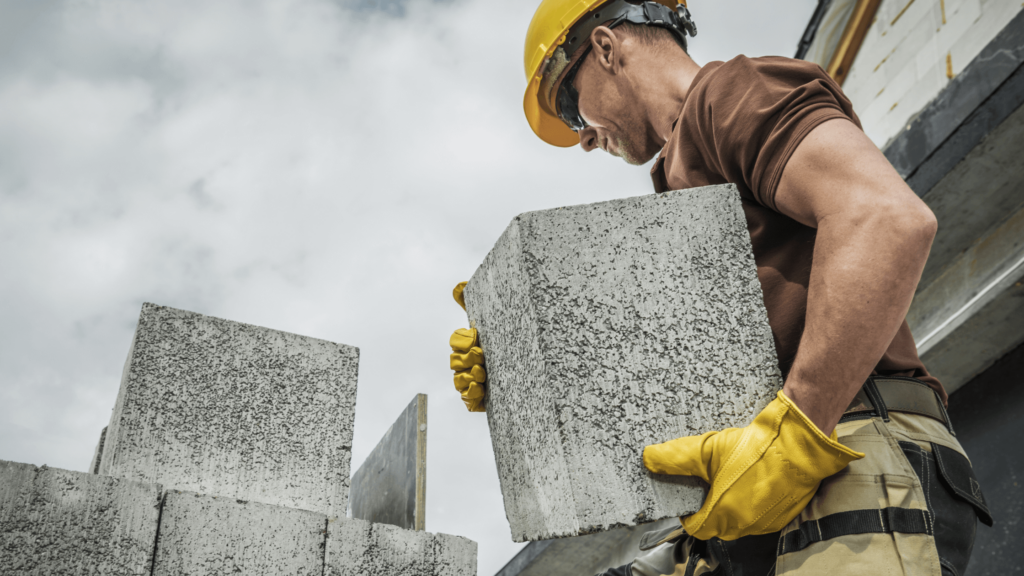Long hours of heavy lifting, climbing, and repetitive tasks can leave even the most seasoned construction workers feeling drained. Add in the heat of summer or the chill of winter, and the job’s physical toll can be immense. While a healthy diet, good sleep, and exercise are the best ways to help your body recover from these factors, creatine can be an additional strategy to stave off the physical and mental effects of labor jobs.
What is creatine?

Creatine is a natural compound in your muscles and brain that helps produce energy for physical activity. It’s made by the body and can also be found in small amounts in foods like red meat and fish. Many people use creatine supplements to increase their energy levels and improve performance, especially during high-intensity activities.
Most supplements use creatine monohydrate, the most widely researched and effective form. When you take creatine, your muscles store it for quick bursts of energy, making it a popular choice for athletes, gym-goers, and anyone who does physically demanding work.
How creatine works
Creatine works by increasing the body’s ability to produce energy quickly. When you perform high-intensity tasks like lifting heavy materials or climbing ladders, your muscles rely on adenosine triphosphate (ATP) for energy. However, ATP stores deplete quickly, usually within a few seconds of intense activity. Your body replenishes these ATP levels through the creatine phosphate system, allowing your muscles to sustain power and recover faster. You can replenish these stores faster through supplementation, which has been shown in many studies to improve strength and endurance during physically demanding activities.
In addition to fueling your muscles, creatine also benefits your brain. By increasing phosphocreatine (PCr) levels in the brain, creatine supports energy metabolism and reduces the effects of mental fatigue. This is particularly helpful for maintaining focus and clarity during long work days or under stressful conditions.
Why creatine is beneficial for workers in physically demanding jobs

Construction work is tough on both the body and mind. From heavy lifting to long hours in extreme weather, the physical and mental demands can leave you drained. This is where creatine steps in as a simple and effective way to improve the following:
- Increases muscle strength and performance: Creatine has been shown to boost muscle strength and power by 10–20%, making it easier to handle heavy lifting and repetitive tasks day after day.
- Boosts energy production: By increasing ATP, the body’s primary energy source, creatine helps muscles perform better during short bursts of intense effort—perfect for lifting heavy materials or powering through demanding shifts.
- Improves recovery and reduces muscle damage: Strenuous work can take a toll on your muscles. Creatine reduces inflammation and muscle damage, helping you recover faster so you’re ready to go again the next day.
- Supports cognitive function: Long hours on the job can be mentally exhausting. Creatine has been shown to increase brain energy levels by 5–15%, improving memory, focus, and mental clarity—especially important for tasks that require quick thinking.
- Promotes hydration and heat tolerance: Creatine helps muscles retain water, reducing the risk of dehydration and heat fatigue—essential for those hot summer days on the job site.
Safety and recommended usage for construction workers
Creatine is one of the most researched supplements available and is widely regarded as safe for long-term use when taken at recommended doses. For most people, a daily dose of 3–5 grams of creatine monohydrate is effective for maintaining optimal muscle levels. This amount supports energy production, muscle recovery, and cognitive function without overwhelming the body.
When starting to supplement with creatine, some people use a “loading phase” of 20 grams per day (split into four doses) for 5–7 days to quickly saturate their muscle stores, followed by a maintenance dose of 3–5 grams daily. However, skipping the loading phase and simply taking five grams daily is equally effective over time. It’s best to take creatine with water; many find it beneficial to consume it after meals to aid absorption.
Common misconceptions about creatine
Creatine is one of the most studied supplements in the world, but misconceptions about its safety and effectiveness persist. Let’s clear up some of the most common myths:
- Creatine damages your kidneys: This is one of the most widespread myths, but research has consistently shown that creatine does not harm kidney function in healthy individuals. Studies involving long-term creatine use (up to 5 years) have found no adverse effects on kidney health. However, individuals with pre-existing kidney conditions should consult their doctor before starting any supplement.
- Creatine causes dehydration and muscle cramps: Another myth suggests that creatine pulls water into the muscles, leading to dehydration or cramping. Research shows that creatine can improve hydration by increasing water retention in muscle cells, which may even help prevent cramps during intense physical activity.
- Creatine makes you gain fat: Although creatine can cause a slight increase in weight due to water retention in the muscles, it does not lead to fat gain. In fact, when paired with physical activity, creatine is often associated with increased lean muscle mass and improved body composition.
- Creatine is only for bodybuilders: While creatine is popular among athletes and gym-goers, its benefits extend far beyond the gym. Construction workers, laborers, and anyone with a physically demanding job can benefit from creatine’s ability to boost strength, endurance, and recovery. It’s a supplement for anyone looking to support their physical and mental performance.
How to choose the right creatine supplement
When it comes to selecting a creatine supplement, you should consider a few factors. The first factor is the type of creatine.
The gold standard is creatine monohydrate, which has been extensively studied and proven to improve strength, recovery, and cognitive function. It’s also the most affordable option, making it the go-to choice for most people. Other forms of creatine, such as creatine hydrochloride (HCL), buffered creatine, or liquid creatine, are marketed with claims of better absorption or reduced side effects. However, these alternatives often come at a higher price without significant evidence to support their superiority over monohydrate. Creatine monohydrate remains the best choice due to its proven effectiveness and cost-efficiency.
The second factor to look out for is whether it has minimal ingredients—pure creatine monohydrate without added fillers or unnecessary additives is ideal. Also, make sure to check for third-party testing or certifications, such as NSF Certified for Sport or Informed Choice, to ensure the supplement is free from contaminants and accurately labeled.
Cost-wise, creatine monohydrate is highly affordable, with a month’s supply typically costing around $10–20. Compared to other types of creatine, it offers the best balance of price and performance. For construction workers looking to improve their physical and cognitive performance without breaking the bank, creatine monohydrate is a practical and effective option.
Is creatine right for you?
Creatine offers a wide range of benefits for construction workers, from boosting energy and strength to improving recovery and even supporting cognitive function. It’s a well-researched, safe, and affordable supplement that can help meet the demands of a physically intensive job while keeping you sharp and ready for each day.
However, creatine isn’t a one-size-fits-all solution. While most people can safely benefit from a daily dose of 3–5 grams, individuals with pre-existing health conditions should consult a healthcare professional before starting supplementation.
Want more tips on improving your performance and staying healthy in demanding jobs? Subscribe to our newsletter and follow us on social media for expert advice, practical solutions, and the latest insights!



1 comment